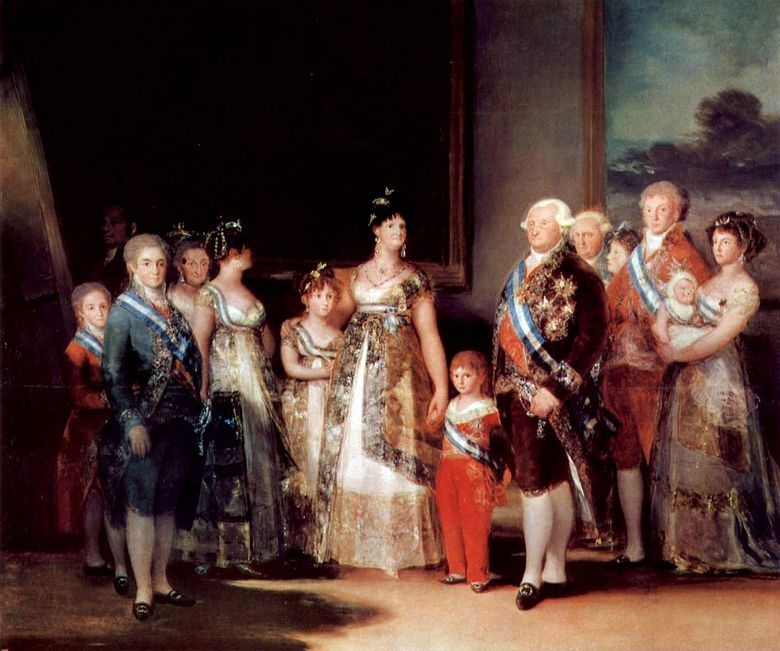
King Charles IV ordered Goya to write a group portrait of the royal family. Previously, Goya made sketches of individual members of the family, and then proceeded to the group portrait and completed it very quickly. During the year the painting was finished. We see luxurious suits shining with jewels and royal regalia, however, the faces of the royal couple testify to the depressing lack of character.
The boring, inexpressive faces of the luxuriously dressed king and queen make one recall the saying of the French novelist Theophilus Gautier: they resemble a “baker with his wife who received a big win in the lottery.” Not a single character trait of this brilliant family escaped the artist’s penetrating look.
A haughty, arrogant man in the blue jacket on the left is the eldest son of the king, later a tyrant, Ferdinand VII. Nearby, turning away from him, stands his alleged bride, who has not yet received an official proposal. Queen Maria-Louise, surrounded by younger children, is in the center of the picture, and the king stands apart, repeating the situation that has developed in their life; all his appearance expresses respect to his royal wife. Behind the king’s back other, less significant relatives were grouped.
Perhaps imitating the masterpiece of Velasquez – “Meninam” and repeating his own manner, recorded in his other paintings, Goya portrayed himself in the background, diligently working on a large canvas. In 1800, Goya began work on a family portrait of King Charles IV. “It will be a picture where we are all pictured together,” Queen Maria Louise wrote to her prime minister and favorite Godoy. Goya carefully prepared for work, he performed a large series of sketches, which captured the faces of the characters of this large canvas. Some of these etudes are stored in the Prado, others are lost and are known only by copies.
Searching for the compositional solution of this family portrait, Goya fundamentally refused all that was created in the front panel portrait before him. Goya put the royal family in a row, the center of which became the figures of the obese King Carlos and his ugly wife Maria – Louise. The artist gives an accurate psychological description to each of the portrayed. The interpretation of the images of representatives of this royal family is extremely truthful, the images are so authentic, as if written on the verge of a grotesque.
Considering this portrait, we see in it something reminiscent of a caricature and a fantastic one at the same time. Only an artist like Goya, clearly aware of the scale of his talent and, perhaps, sufficiently secured to risk his position as the First Court painter, could venture to write a true portrait of royalty. In the portrait, there is not the slightest desire to decorate Queen Mary-Louise, the artist did not miss a single detail: a double chin and a thick neck are conspicuous, just like a rough, almost vulgar expression; her hands, which, as Goya knew, she admired, considering them seductively round, seem too fat.
In contrast to her, her youngest daughter, Dona Maria Isabel, reminds an angel, her dress, jewels and eyes are the same as her mother’s, but she radiates the tenderness and charm of her youth, which shows not only her innocence, but also the unchanged Goya’s sympathies for children. True to the truth of life, Goya’s portrait did not seem to shock anyone; even the queen on occasion joked about her ugliness, perhaps, waiting in response to fervent objections. The royal couple expressed neither displeasure nor enthusiasm when they saw the work presented to them. And, although Goya never again received royal orders, it was not because they were offended by the portrait.
 Family of the Dukes of Osuna by José Francisco de Goya
Family of the Dukes of Osuna by José Francisco de Goya Portrait of Queen Maria Luisa of Parma by Francisco de Goya
Portrait of Queen Maria Luisa of Parma by Francisco de Goya Portrait of Francisco Baieu by Francisco de Goya
Portrait of Francisco Baieu by Francisco de Goya Portrait de famille de Charles IV – Francisco de Goya
Portrait de famille de Charles IV – Francisco de Goya Portrait of Dona Teresa Luisa de Sureda by Francisco de Goya
Portrait of Dona Teresa Luisa de Sureda by Francisco de Goya Equestrian portrait of Charles I by Anthony Van Dyck
Equestrian portrait of Charles I by Anthony Van Dyck Portrait of the Countess de Chinchón by Francisco de Goya
Portrait of the Countess de Chinchón by Francisco de Goya Portrait of Señora de Sean Bermudez by Francisco de Goya
Portrait of Señora de Sean Bermudez by Francisco de Goya